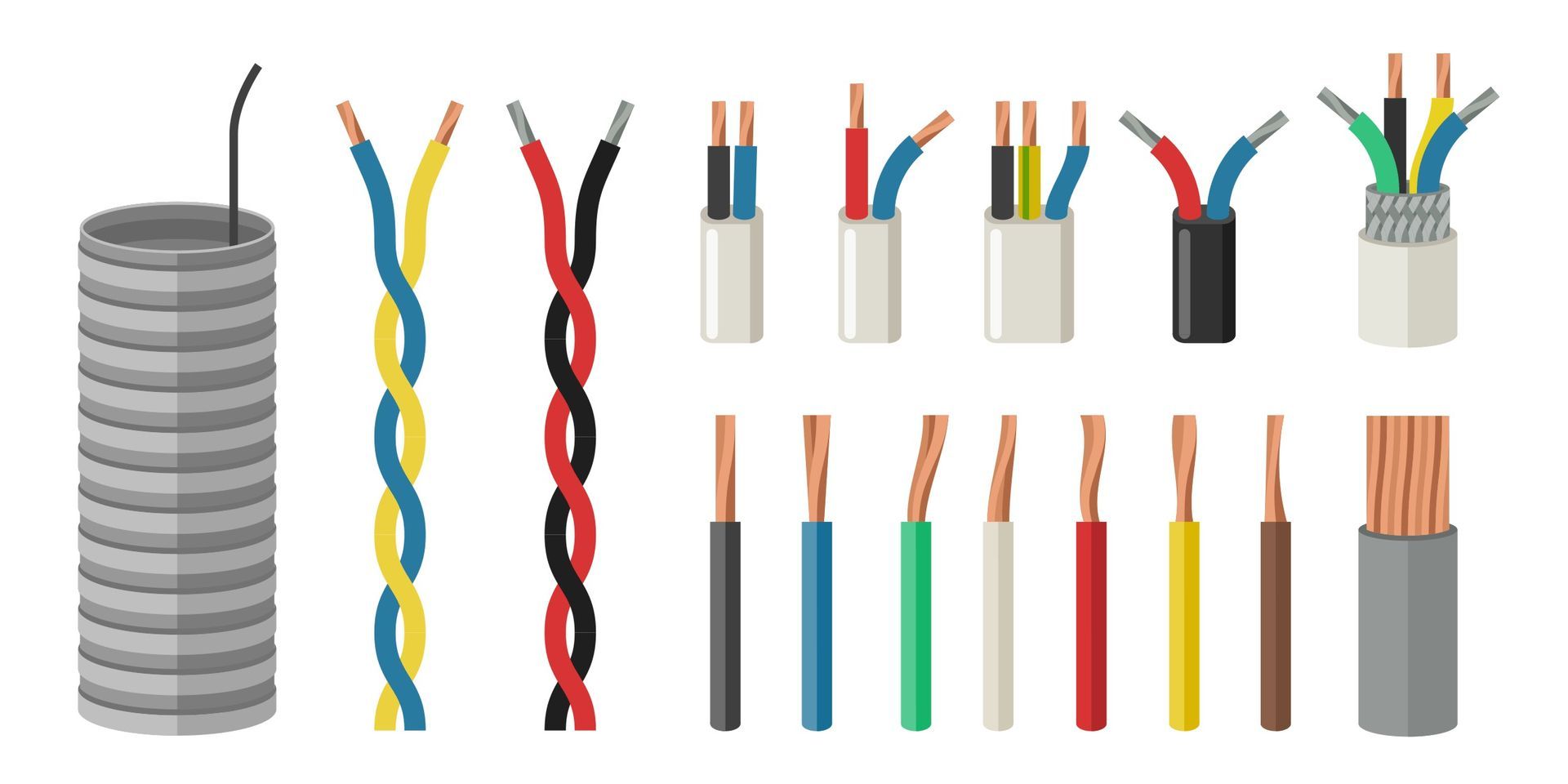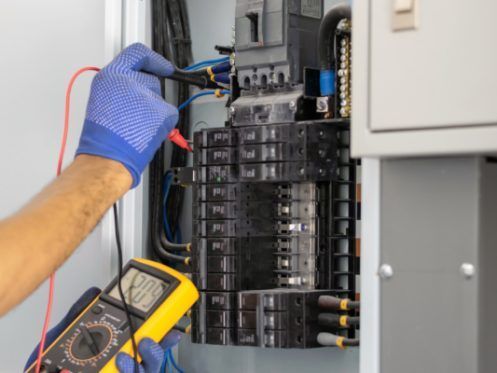Explaining Residential Electrical Wire Colors: Which Color Wires are Hot, Neutral & Ground in Edmonton, Glasgow & Columbia, KY?
For any project involving your Edmonton, Glasgow & Columbia, KY, home's electrical wiring, understanding the electrical color coding of wires is not just useful, it's empowering. These electrical wire colors are more than mere decoration-they serve as a code, providing a uniform system for identifying the purpose of each electrical wire.
This knowledge of residential electrical wire colors is the key to working safely and avoiding potentially disastrous and dangerous errors. Identifying which wire is hot, neutral, or ground allows you to protect yourself from electric shock and safeguard your home's electrical system against damage, putting you in control of your home's safety.
Within North America, the standard color assignments dictate the following: Black wires typically signify "hot," referring to the conductors that carry electrical current from the power source to the intended outlet or appliance.
White wires usually serve as the "neutral" pathway, allowing the current to return to its source safely. Grounding is the domain of green wires, or those of bare copper, which provide a secure route for stray electricity to follow in the event of a system fault, protecting both people and devices. Remember, local regulations can introduce subtle variations to electrical codes, so it's crucial to remain vigilant about adherence to community stipulations.
When uncertainty clouds any aspect of your home's wiring, seeking counsel from a qualified electrician is the safest course of action. ACDC-Electric in Edmonton, KY, is ready to address any electrical inquiries or concerns you may have. Always remember that when working with electricity, prioritizing safety is not just important, it's paramount. You can feel reassured that professionals are there to help you navigate any electrical issues.
About the Residential Electrical Wire Colors in Edmonton, Glasgow & Columbia?

About the Residential Electrical Wire Colors, ACDC-Electric Edmonton, Glasgow & Columbia, KY
Understanding the meaning of electrical wire color codes in your Edmonton, Glasgow & Columbia home is not just helpful, it's empowering. It's vital for ensuring safety and the success of any DIY electrical work. A standardized system of colors, used across North America, allows electricians and homeowners to quickly identify a wire's purpose, thereby reducing the risk of electrical shocks, short circuits, and potential fires. Before undertaking any electrical repair or new installation, it's essential to understand these established color assignments, as failing to do so could lead to serious hazards.
Typically, the colors most often encountered include black, white, green (or uninsulated copper), and red. Black wires usually function as 'hot' conductors, charged with transporting electrical current from the power source to a switch or receptacle. White wires, on the other hand, act as 'neutral' conductors, completing the circuit by returning the current to the source. Green or bare copper wires, crucially, serve as grounding conductors, designed to conduct electricity safely to the ground in the event of an electrical fault. Furthermore, red wires may also be hot wires, often deployed to complete switch circuits or utilized within three-way switch configurations.
Despite the existence of these standard color assignments, it's always prudent to independently verify the voltage of each wire before commencing any work. Older residences may feature wiring installations that predate current color coding standards or were improperly implemented due to previous DIY attempts. If uncertainty arises, the best course of action is always to consult with a licensed electrician. Their expertise can verify personal safety and ensure the correct functionality of your electrical circuits. For any electrical wiring concerns or questions, ACDC-Electric in Edmonton, KY, is always ready to assist.

Residential Neutral Wire Color: White or Gray
Within residential electrical networks, the neutral wire is a crucial element in circuit completion, serving as the conduit for the return current. Its color-coded insulation, either white or gray, makes it easily identifiable, thereby promoting safety and correct wiring. This standardization allows electricians and homeowners to quickly distinguish the neutral wire from live and ground wires, thereby reducing potential hazards such as electrical shocks and short circuits.
Enforced across the majority of nations, electrical codes and regulations mandate the use of white or gray for neutral wires, ensuring consistent implementation of safety protocols. These codes provide precise guidelines for electrical installations, particularly in the crucial area of wire color identification, ensuring uniformity and safety in their application.
Adhering to these formalized guidelines enables electricians to swiftly and accurately pinpoint the neutral wire, even within intricately configured wiring systems, thereby reducing the chance of errors during installation work, scheduled maintenance, or necessary repairs.
While white remains the predominant color designation for neutral wires in residential contexts, gray serves as an accepted alternative. Both manufacturer preferences influence the selection of either white or gray, in addition to wiring type specifications. Regardless of the chosen color, the foremost priority involves ensuring the secure connection of the neutral wire to the appropriate neutral terminal across electrical panels, power outlets, and other corresponding components.
Confirming precise functionality of entire systems, this protocol further minimizes latent risks related to potential electrical exposure.
Residential Electrical Hot Wire Color – Red or Black or Blue
In residential electrical systems, pinpointing the energized conductor is paramount for ensuring safety and correct functionality. The energized conductor, otherwise known as the live wire, transmits electrical current from the power source to the outlet or device in question. The use of specific color schemes for identifying live conductors in North America is a safety measure. While these color codes are subject to localized variations, they are standardized to ensure uniformity and safety.
Primarily, black and red are used to insulate the energized conductor. In 120-volt circuits, black is often used as the principal marking, while red typically marks the secondary conductors, as is usually the case in 240-volt setups or with bundled circuit arrays. Although less frequently than its black and red counterparts, one may discover circuits where blue denotes a live state within the cabling.
It's important to remember that standardization doesn't guarantee the universal application of any identification method, whether it's a mark or a color code. Before you engage with any circuitry or system components in residential electrics, it's essential to seek expert consultation from a registered electrician.
This, along with verified indications by testing of ‘no-contact’ voltage over potentially conductive surfaces within the system, will ensure compliance with relevant local jurisdictions for building and residential electrical code ordinances, and, governing electrical safety operating instructions.
Failing to confirm the correspondence between displayed-mark-state-indication and the actual state of the system beforehand could lead to serious, and potentially fatal, risks.
Residential Electrical Ground Wire Color – Green or Bare
Understanding electrical wire color code is not just a matter of knowledge, but a crucial element in navigating the complexities of residential electrical wiring systems. Electrical wire color coding plays a pivotal role in ensuring both operational integrity and adherence to stringent safety standards. The ground wire serves as a critical safety measure by providing a conduit for aberrant electrical flow.
It is typically distinguished by precise colorimetric conventions, most commonly green or, at times, left bare (uninsulated).
In typical residential electrical circuits, the green hue of the ground wire is a clear marker of the grounding conductor. This wire is connected to the dwelling's grounding architecture, often anchored to a subterranean metal rod or the incoming metallic water mains.
Its primary role is to provide a low-resistance pathway for abnormal electrical events, thereby mitigating the risk of electrocution and preventing damage to appliances. Regardless of superficial color congruence, meticulous verification of all conductors with a multimeter is crucial before initiating any electrical intervention. Neglecting this principle can lead to perilous scenarios.
Erroneous connections may not only result in potentially lethal electrical discharges but also create circumstances conducive to electrical conflagrations and potentially irreparable harm to affiliated equipment. In such instances of uncertainty, immediate consultation with a certified electrical professional is not just advised but emphatically recommended.

Electrical wiring color conventions serve as standardized guidelines, clarifying the function of individual conductors. Adherence to these classifications proves indispensable for maintaining safety and forestalling electrical mishaps. By recognizing each wire's designation, electricians and homeowners can markedly diminish the hazards of electrocution, short circuits, and fire outbreaks. Because specific color conventions vary by nation or locale, it is crucial to heed regional codes before undertaking any electrical work, instilling a sense of caution and responsibility. It is invaluable when dealing with any electrical system.
Whether acting as a certified professional or implementing a home-based DIY endeavor, understanding established codes facilitates the avoidance of grievous errors and ensures personal and public well-being. You should always cross-reference regional regulatory measures and solicit counsel from an accomplished and certified electrician when experiencing concerns about the properties and protocols associated with your setup.
Color Wiring Code in Edmonton, Glasgow & Columbia, KY
Electrical wiring relies on a standardized color code to ensure both security and uniformity. This intentional designation empowers electrical technicians to promptly identify the role of each conductor, thereby reducing the risk of electrical discharge and preventing faults during installation. For anyone engaging with electrical systems, whether a homeowner undertaking basic repairs or a professional installing complex circuits, understanding this categorical system is paramount.
Within the North American context, chromatic designations generally adhere to the following precepts: Black conductors typically serve as energized lines, channeling electrical current from its source. Conversely, white conductors function as neutral returns, conveying current back to its source.
Green conductors, or those composed of bare copper, serve as grounding pathways, providing a secure route for electricity in the event of a fault. Tertiary hues, encompassing red and blue, find utilization in discrete functions such as switch legs or within multi-wire branch circuits. It remains vital to acknowledge the possibility of slight divergence within these conventions contingent upon localized stipulations and specific utilization parameters.
Consequently, diligent consultation with local electrical ordinances and schematic representations is strongly advised before undertaking any electrical task. Should uncertainties arise, engaging a proficient electrician to ensure both precision and safety is invariably the optimal recourse. This professional guidance is a key factor in preventing hazardous eventualities, potentially precipitating both combustion hazards and grievous bodily harm through electrocution.
Which wire color is typically used for hot in residential wiring?
Black is the wire color most commonly used for hot wires in residential electrical wiring. Black wires carry current from the electrical panel to outlets, switches, and fixtures. Red is also frequently used as a hot wire, especially as a secondary hot in 240-volt circuits or for switch legs. In some cases, blue or yellow wires may serve as hot wires, particularly in specialized applications or multi-way switch setups, but black remains the standard and most recognizable hot wire color in homes.
Always verify wire function with a tester before working, as wire color alone is not a guarantee—especially in older homes or if previous work was not done to code
How can I Safely Identify Neutral and Ground Wires in My Home?
Safely identify neutral and ground wires in your home, follow these steps:
1. Visual Inspection (Color Codes)
- Neutral wires are typically white or gray.
- Ground wires are usually green, green/yellow striped, or bare copper.
- However, do not rely solely on color, especially in older homes or where previous work may have altered standard codes.
2. Using a Digital Multimeter
- Set the multimeter to AC voltage mode.
- Identify the hot wire first (usually black or red) by measuring voltage between each wire and a known ground; the hot will read around 120V (in the US).
- To distinguish neutral from ground:
- Measure the voltage between the suspected neutral and the known hot wire; it should read about 120V.
- Measure the voltage between the suspected ground and the hot wire; it should also read about 120V.
- Now, measure the voltage between the suspected neutral and ground. The neutral wire will show a small voltage difference (typically 1–5V), while the ground should show 0V.
“To check which one is neutral, you’ll need to check load voltage on both the ground and neutral. While under load the neutral will be closer to line voltage (120V) than the ground. The ground carries no current so there is no voltage drop. … 0V is ground, small voltage is neutral.”
3. Physical Clues
- Ground wires may be attached to a green screw, the metal box, or run as a bare wire to a grounding rod or pipe.
- Neutral wires are often grouped together in the back of outlet boxes, capped with a wire nut.
4. Safety Tips
- Always turn off power at the breaker before inspecting or working on wires.
- Never assume a wire’s function based on color or appearance alone—always verify with a tester or multimeter.
- If you are unsure or your wiring does not match standard practices, consult a licensed electrician..
Residential Electrical Wire Colors: Which Color Wires are Hot, Neutral & Ground? FAQ’s
Title or What happens if I mix up hot, neutral, and ground wires?Question
Mixing up wires can cause short circuits, electrical shocks, or fire hazards. Always double-check wiring before connecting or energizing circuits.
Can a white wire ever be hot?
Yes, in some cases, a white wire may be used as a hot wire (for example, in switch loops). If so, it should be marked with black or red tape to indicate it’s “hot”.
Is it safe to use a ground wire as a neutral?
No. Neutral and ground serve different purposes and must not be interchanged. The neutral carries return current, while the ground is a safety backup.
How can I identify wires if the colors are faded or missing?
Use a voltage tester or multimeter to test each wire. Always turn off power at the breaker before working on any wiring.
Are these color codes universal?
No. While these are the standard colors in the United States (per the National Electrical Code), other countries may use different color schemes.
What if I see a wire with a different color?
Occasionally, older homes or DIY wiring may not follow standard codes. Always test wires before working on them and consult a professional electrician if unsure. Call 270-393-5007
What if my house has older wiring with different colors?
Older homes may use different color codes or lack ground wires. If you’re unsure, consult a licensed electrician before making changes.
Is it safe to work on electrical wiring myself?
If you are not experienced, it’s best to hire a licensed electrician. Incorrect wiring can be dangerous and is often against local codes.
Why You Should Choose AC-DC Electric Edmonton, KY?
If you’re still having trouble finding the right electrician to help you with your residential electrical issues, consider contacting AC-DC Electricedmonton. We maintain a network of reliable and affordable electricians who can offer assistance.
Our Experience
At AC-DC Electricedmonton we have been offering both residential, commercial and industrial electrical services for over four decades. Our experience has taught us the best ways to perform various procedures. Our management and staff have seen residential electric systems evolve over time and have gained a deeper understanding of how they work. Thanks to our experience, we rarely encounter issues that we have never seen before.
Our knowledge
Each of our electricians and technicians is licensed, certified, and trained to provide high quality electrical services. We understand the importance that electric systems play in both residential and commercial properties. This is why we handpick the best electricians who are both knowledgeable and have demonstrated their ability in a variety of situations.
At AC-DC Electricedmonton, we foster an environment that encourages excellence. You can count on our electricians and technicians to get the job done with both speed and skill.
Our Transparent Pricing
Dealing with an electrical problem at home can be incredibly distressing, and many electricians and companies are willing to exploit people experiencing such issues by charging them high fees. At AC-DC Electricedmonton, we strive to provide high quality services at affordable rates.
Our electricians can also offer you a free estimate before you hire them. This ensures you remain aware of how much you will need to pay before using our electrical services.
If you’re ready to tackle your residential property’s electrical problems quickly, please contact AC-DC Electricedmonton today. Our experts are always happy and ready to help residents in Edmonton, Glasgow and Columbia, KY.
Call today for a free estimate at 270-393-5007
